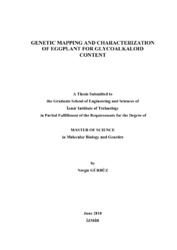Please use this identifier to cite or link to this item:
https://hdl.handle.net/11147/3516Full metadata record
| DC Field | Value | Language |
|---|---|---|
| dc.contributor.advisor | Doğanlar, Sami | en |
| dc.contributor.author | Gürbüz, Nergiz | - |
| dc.date.accessioned | 2014-07-22T13:51:43Z | - |
| dc.date.available | 2014-07-22T13:51:43Z | - |
| dc.date.issued | 2010 | en |
| dc.identifier.uri | http://hdl.handle.net/11147/3516 | - |
| dc.description | Thesis (Master)--Izmir Institute of Technology, Molecular Biology and Genetics, Izmir, 2010 | en |
| dc.description | Includes bibliographical references (leaves: 74-78) | en |
| dc.description | Text in English; Abstract: Turkish and English | en |
| dc.description | xii, 103 leaves | en |
| dc.description.abstract | Most plants including eggplant, produce toxins against insects, pathogens and animals. The biggest class of these toxins is alkaloids. Generally plants produce alkaloids in a glycosidic form which are called glycoalkaloids. Glycoalkaloids have toxic effects on human health. For example, as a result of disrupting the cell membrane, the gastrointestinal track and other organs are damaged. Glycoalkaloids are not only toxic to human health but also they have beneficial effects. For example, they decrease cholesterol level, and have anticancer activity. And also they are used as a precursor for steroidal drugs. Therefore, isolation and determination of glycoalkaloids content is important. For this aim, column chromatography was performed and solamargine and solasonine were obtained. Totally 122,8 mg solamargine, solasonine and solamargine and solasonine mix from Solanum linnaeanum were obtained. Their identities were confirmed via 1H NMR and mass spectroscopy. For determination of glycoalkaloid content HPLC method was developed via changing different parameters such as mobile phase, pH, temperature, flow rate and column type. It was found that separation of glycoalkaloids by using RP column without phosphate buffer was not sufficient. On the other hand, separation of glycoalkaloids by using carbohydrate column was better but this type of column is not stable. Furthermore, linkage mapping was performed by using CAPs and SSR methods; and 385 COSII markers and 221 SSR markers were tested. Of the tested markers, 38 of the COS II markers and 28 of the SSR markers were found to be polymorphic. A total of 52 of these markers were mapped. | en |
| dc.language.iso | en | en_US |
| dc.publisher | Izmir Institute of Technology | en |
| dc.rights | info:eu-repo/semantics/openAccess | en_US |
| dc.subject.lcsh | Plant genome mapping | en |
| dc.subject.lcsh | Plant metabolites--Biotechnology | en |
| dc.subject.lcsh | Eggplant | en |
| dc.subject.lcsh | Alkaloids | en |
| dc.title | Genetic mapping and characterization of eggplant for glycoalkaloid content | en_US |
| dc.type | Master Thesis | en_US |
| dc.institutionauthor | Gürbüz, Nergiz | - |
| dc.department | Thesis (Master)--İzmir Institute of Technology, Molecular Biology and Genetics | en_US |
| dc.relation.publicationcategory | Tez | en_US |
| item.languageiso639-1 | en | - |
| item.openairecristype | http://purl.org/coar/resource_type/c_18cf | - |
| item.openairetype | Master Thesis | - |
| item.cerifentitytype | Publications | - |
| item.fulltext | With Fulltext | - |
| item.grantfulltext | open | - |
| crisitem.author.dept | 04.03. Department of Molecular Biology and Genetics | - |
| Appears in Collections: | Master Degree / Yüksek Lisans Tezleri | |
Files in This Item:
| File | Description | Size | Format | |
|---|---|---|---|---|
| T000840.pdf | MasterThesis | 3.55 MB | Adobe PDF |  View/Open |
CORE Recommender
Page view(s)
168
checked on Oct 14, 2024
Download(s)
180
checked on Oct 14, 2024
Google ScholarTM
Check
Items in GCRIS Repository are protected by copyright, with all rights reserved, unless otherwise indicated.